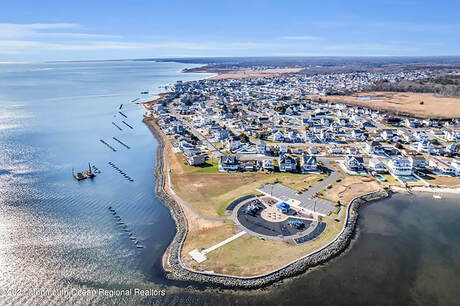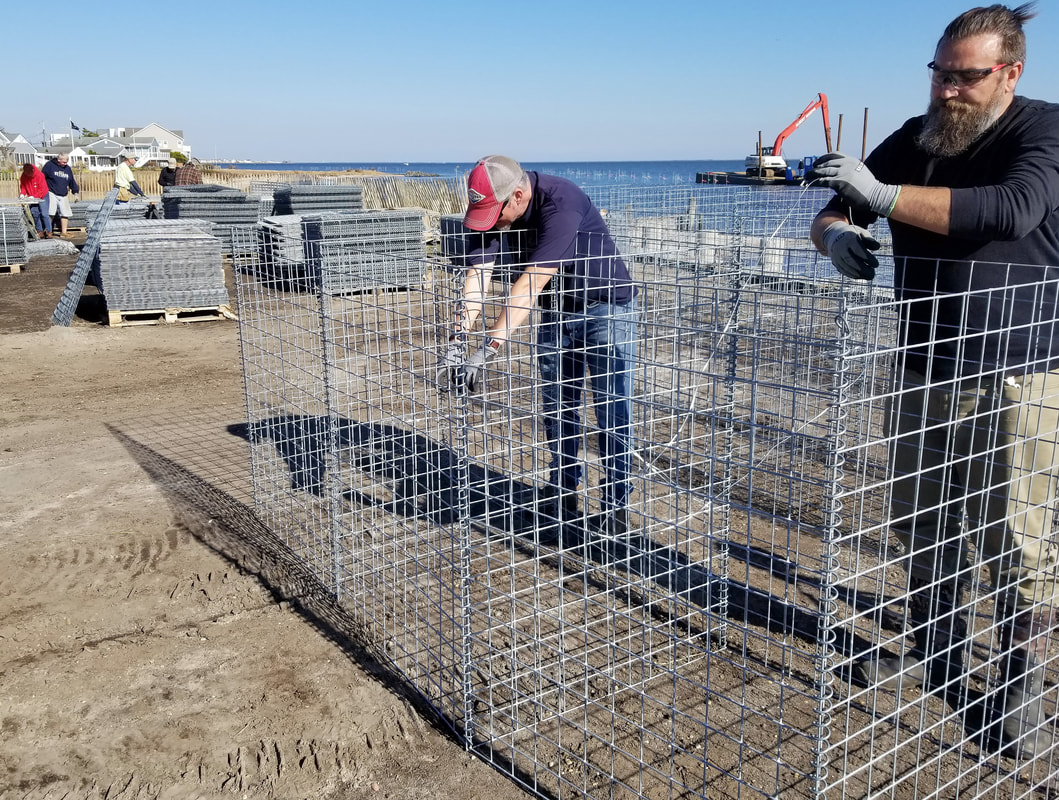|
Work on the Forked River Beach project has been underway for a few weeks and folks may be wondering what is next. Through this project we are advancing our goals of restoring oysters to the waters of Barnegat Bay and developing nature-based approaches to community resilience in response to climate change impacts along our coast. The answer is shell, of course. But before we get into that, let's recap. The work at Forked River Beach finally got underway in early November with the delivery of materials for constructing the containers that will fill seven, 200-foot long, double-rowed oyster reef segments. Called HESCOs, these large, galvanized wire baskets had to be put together before being carried by barge to the reef site and filled with stone to anchor them in the locations staked out by Stockton University. For this project, each HESCO unit/reef segment will consist of three connected galvanized steel baskets surrounded by eight outer pockets (aka shell faces). The interior baskets will be filled with rock, while the outer shell faces will be filled with a mix of recycled shell.  A steady stream of volunteers showed up nearly every day into early December to work side-by-side with Littoral Society Habitat Restoration staff on assembly of each HESCO. The majority of volunteers came from the surrounding community in Lacey Township, NJ and from ReClam The Bay, but more than a few came from schools and other areas of the state. At this point all of the HESCOs have been finished and most positioned from the mouth of Forked River in the north, near Bayfront Park, to a lagoon located at the southern end of Beach Boulevard. This section has lost over a hundred feet of shoreline since 1995 and the erosion rate has been accelerating. Starting next week, whelk shell will be delivered from Cape May, along with recycled oyster and clam shell donated by the Jetty Rock Foundation. The recycled shell came from restaurants located in Ocean County. They will be mixed together, then loaded on a barge. About a dozen loads of “bare” shell (shell not seeded with oysters) will be needed. That shell will be placed in the outer face of the basket segments on the offshore reefs, encapsulating the rock core and creating a hybrid living shoreline. Once filled, mesh lids will be secured to the top of the reef segments to prevent rock and shell loss. Once lids are all secure, we will install up to 8 pilings around each of the 7 inshore and offshore reefs. The pilings will be used to break ice, allow for a place to post signage and navigational aids, and provide a place to mount security cameras. In late spring/early summer of 2022, we will add “live” shell to the inshore reefs that has been set with up to 70 million oyster larvae. We hope that once the oysters placed at the inshore reefs mature, they will produce the larvae needed for oysters to begin growing on the offshore reefs. We will be monitoring the project to find out. Mouth of the Maurice River Restoration Project Update We have permits in place and a project timeline, along with funding from the National Fish and Wildlife Foundation and NJ Department of Environmental Protection. As a result, we are ready put out a bid to marine contractors with the hopes of a February 2022 start for Phase 1 and 2 of the Mouth of the Maurice River Restoration Project. Phases 1 and 2 involve the creation of 600-foot revetment or wall, up to nine hybrid living shoreline breakwaters, marsh restoration, placement of shell to the lee of the breakwaters, and the creation of mussel beds at Basket Flats (near the Heislerville Wildlife Management Area). Once complete, this restoration will protect several communities upriver and also provide some great habitat for fish, crabs, and birds. This is our biggest restoration project yet and includes a third and final phase, which will restore Northwest Reach on the other side of the river across from Basket Flats. That restoration will begin near the end of 2022 or beginning of 2023. We have been told by some community members that they have been waiting for this project for more than 30 years. Thanks to our core partners at Wildlife Restoration Partnerships and Stockton University for all their support, and to ACT Engineering for preparing the bid documents. It is truly a team effort. Comments are closed.
|
Archives
July 2024
Categories
All
|


